Mevlana Museum
|
|
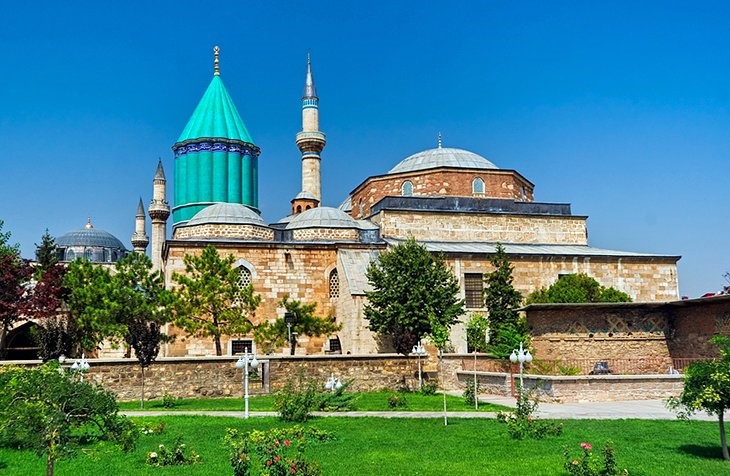
|
|
The symbol of Konya is this tekke (Sufi lodge) complex that holds the tomb of the 13th-century religious leader, philosopher, and poet Mevlana Celaleddin Rumi, who founded the whirling dervish sect of Sufism. The museum is set within lovingly tended rose gardens, which you walk through to the ornate Dervisan Kapisi (Gate of the Dervishes).
Once inside the complex, you enter the Mausoleum, which is the focus of much devotional worship to this day. Mevlana's Tomb is at the far end, flanked by tombs of close family and followers. The Semahane (hall where dervish ceremonies were performed) is just to the left and contains a museum of religious exhibits.
Across the courtyard from the Mausoleum is the lodge kitchen, which contains dioramas of dervish life and is connected to the Dervish Cells, where Sufi followers would have lived and which now contain exhibits on dervish life.
|
Tile Museum (Karatay Medresisi)
|
|
.jpg)
|
|
This old madrassa (theological college) was founded in 1251 by the Seljuk emir Celaleddin Karatay. The building was recently restored and is now an impressive museum showcasing Seljuk enamel tile work.
Although touring a tile museum may sound like a rather niche tourist attraction, the sheer beauty of the building makes this one of the top things to do on a Konya sightseeing itinerary. Its internal walls are covered in gorgeous examples of Seljuk tiling and there are also ceramic exhibits of excavated finds from nearby archaeological sites. In the left-hand room is the tomb of Celaleddin Karatay.
|
Museum of Wooden and Stone Carving (Ince Minare Medrese)
|
|
.jpg)
|
|
The Ince Minareli Medrese (Seminary of the Slender Minaret) lost the minaret in its name when it was struck by lightning in 1905. The madrassa was built in 1260 for the Seljuk vizier Sahip Ata, and the design features richly-sculpted decoration on the portal. The building is now a museum, with a large collection of Seljuk-era wooden and stone sculptures that include animal reliefs (despite depictions of animals and humans being banned by Islamic law) from the old city walls.
|
Alaeddin Tepesi
|
|

|
|
Built on the site of Konya's former citadel, this park, right in the city center, is the place where Konya locals come to promenade in the evening and sip tea in the gardens. At the foot of the incline up the hill, are the excavation site of Alaeddin Kaykobad's palace and the remains of the old city wall. On top of the hill is the Alaeddin Camii, built in the 13th century. It was built as a pillared mosque according to Arabic design, with a wooden ceiling supported by 42 antique columns.
|
Archaeological Museum
|
|
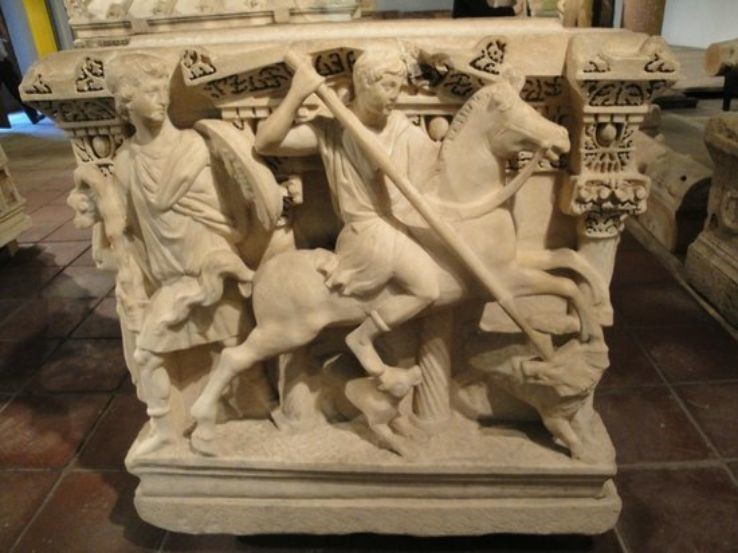
|
|
Most of Turkey's archaeology museums have been jazzed up and modernized in the past decade, but not Konya's museum. This is a dusty old place with poor lighting and information panels that may as well be obsolete. But don't let that put you off, because the collection is excellent (and if you happen to like these relic museums with their treasure-hunt atmosphere, go now before it gets its much-needed facelift). There is a comprehensive display of finds from the nearby archaeological site of Çatalhöyük and a wonderful collection of intricately decorated Roman sarcophagi.
Just down the road is Konya's Ethnography Museum, which holds a thorough collection of Turkish crafts, costumes, jewelry, carpets, and household goods but sadly looks a bit dusty and unloved.
|
Selimiye Mosque
|
|
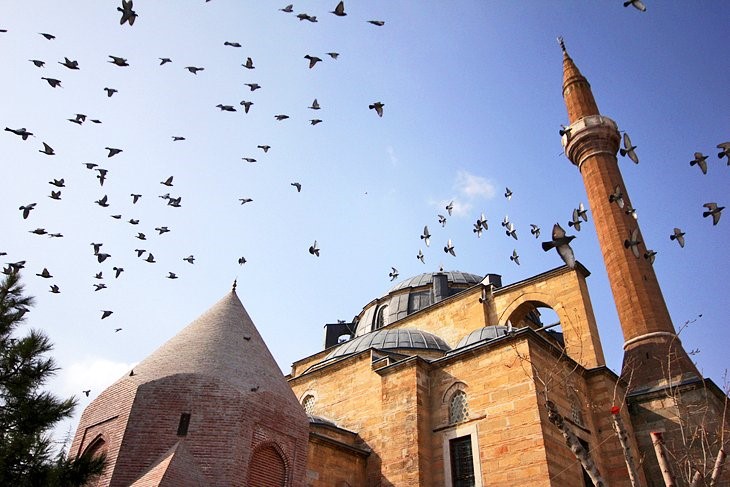
|
|
Standing in the square in front of the Mevlana Museum, this huge domed mosque, commissioned by Sultan Selim II and built between 1566 and 1574, marks the climax of Ottoman mosque architecture. Come to the square in the early evening to get photos of the mosque and Mevlana Museum behind as they are lit up against the dusk sky. Across the main road from the square are a series of outdoor cafés and restaurants, which are a great place to sit down and admire the view of minarets and domes while relaxing with a coffee or tea.
|
Aziziye Mosque
|
|

|
|
Inside Konya's bustling bazaar neighborhood, the Aziziye Mosque is one for architecture fans. It was first built in 1676 by the Ottoman court adviser Mustafa Pasa and reconstructed again in 1867 after a fire. Because of this 19th-century restoration, the mosque's architecture is heavily Baroque-inspired (the style most fashionable at the time), with twin minarets in Rococo style and a brightly painted interior with a Rococo prayer niche. This very European decorative style makes for an interesting contrast with traditional mosque design.
|
Çatalhöyük
|
|
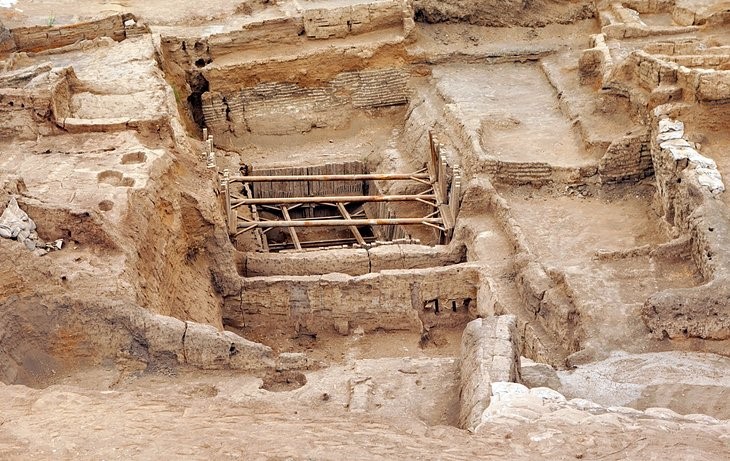
|
|
Although there aren't huge amounts to see, the settlement mound of Çatalhöyük is one of the most important excavation sites in the world. Here, archaeologists have uncovered the largest Neolithic site ever found, with settlement here dating to approximately 9,000 years ago. Excavations are ongoing, and if you visit in summer, you can sometimes watch archaeologists working at the site.
A wonderful little museum at the entry explains the excavation history and the importance of the site. From here, a trail leads you to the twin dig areas (protected under dome shelters), where you can see the deep levels, with clear building outlines, that have been uncovered so far.
|
Sille
|
|
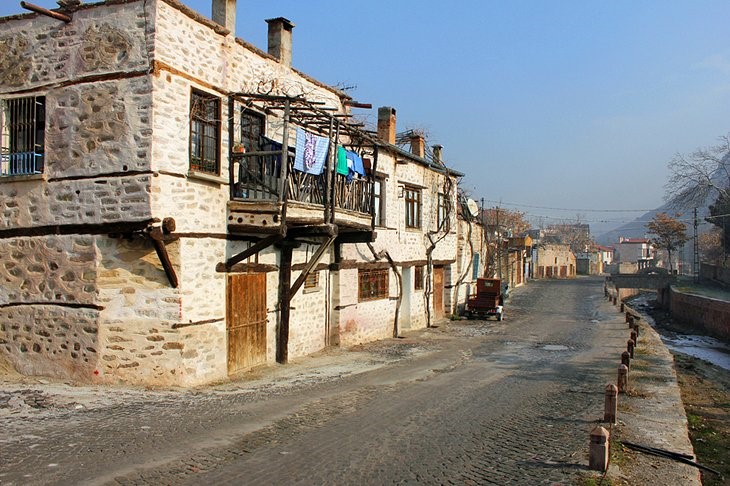
|
|
Cute as a button, the former Greek settlement of Sille is a tiny village just on the edge of the city and a favorite destination for day-tripping Konya locals. Two Byzantine churches are here: St. Helena's and the Küçük Kilise, which have both been recently restored.
St. Helena's Church has an interior covered with colorful frescoes, while the small Küçük Kilise, on the hill behind the village, now functions as a museum dedicated to clocks and other timepieces. The village streets are lined with lovely wooden-beamed houses, while the cliff ridge is pock marked with ancient cave dwellings.
|
Sahib-i Ata Külliyesi
|
|
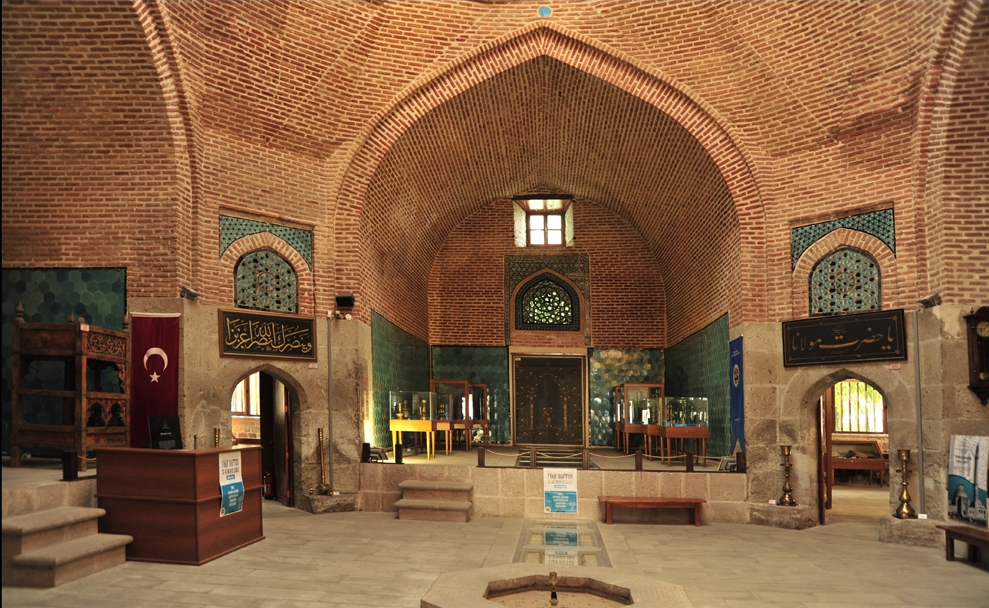
|
|
This religious complex comprises a mosque, dervish lodge, türbe, and baths and was built between 1258 and 1283. The grandly ornate portal gate is beautifully decorated, and the mosque interior has a gorgeous blue-tile prayer niche. The dervish lodge, with its beautifully restored blue-tile and red-brick interior, has been made into a museum with an interesting collection of religious artifacts.
On your way to the mosque you'll pass by the Sirçali Medresi. Built in 1242, this former theological college has some beautiful (but crumbling) examples of tiled decoration on its interior walls and an ornate stalactite portal. It houses a collection of Islamic tombstones, as well as some Hittite funerary urns.
|
Konya Mosques
|
|

|
|
The central city has plenty of other well-preserved examples of religious architecture. In particular, don't miss the Yarn-Makers Mosque (Iplikçi Camii) on Alaeddin Caddesi. Only the mosque remains of this religious complex, built in 1201, which stood to the east of the old citadel in Konya.
The site was initially endowed by a family of yarn manufacturers, hence the name. The square building has two oval, and one round, domes and stands on twelve huge "elephant-foot" columns, with a richly decorated prayer niche made from marble. Both Mevlana and his father once taught here.
The Tower Mosque in the bazaar area is also worth hunting out. It was constructed in 1658, but after falling into disrepair was reconstructed in 1811. The roof of the eight-domed mosque is supported by 10 pillars, and a collection of 14th- and 15th-century garments is in a room inside the building.
|
Koyunoglu Museum
|
|
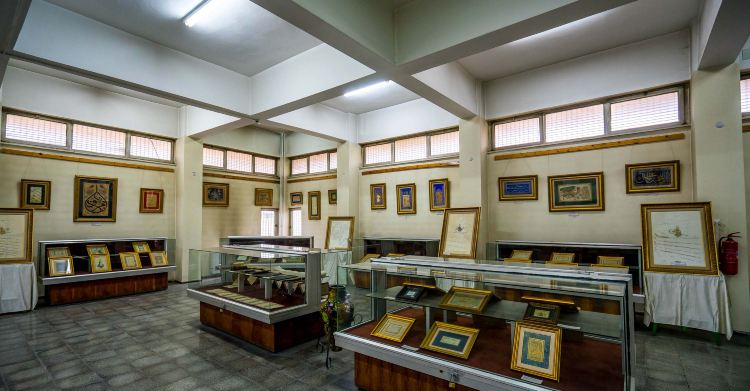
|
|
Avid collector Ahmet Izzet Koyunoglu, a member of one of Konya's oldest families, bequeathed his bizarre and eccentric collection of artifacts, art, ethnography objects, geological items, and just plain stuff, to the city of Konya when he died.
The museum that resulted from this has to be the city's quirkiest sight. The building is a treasure-trove of scatterbrained, weird, and wonderful exhibits that range from rare paintings, manuscripts, and carpets to stuffed animals and clocks. For anyone who appreciates the slightly kooky, this is a wonderful accompaniment to the city's more traditional attractions.
|
Konya Tropical Butterfly Garden
|
|
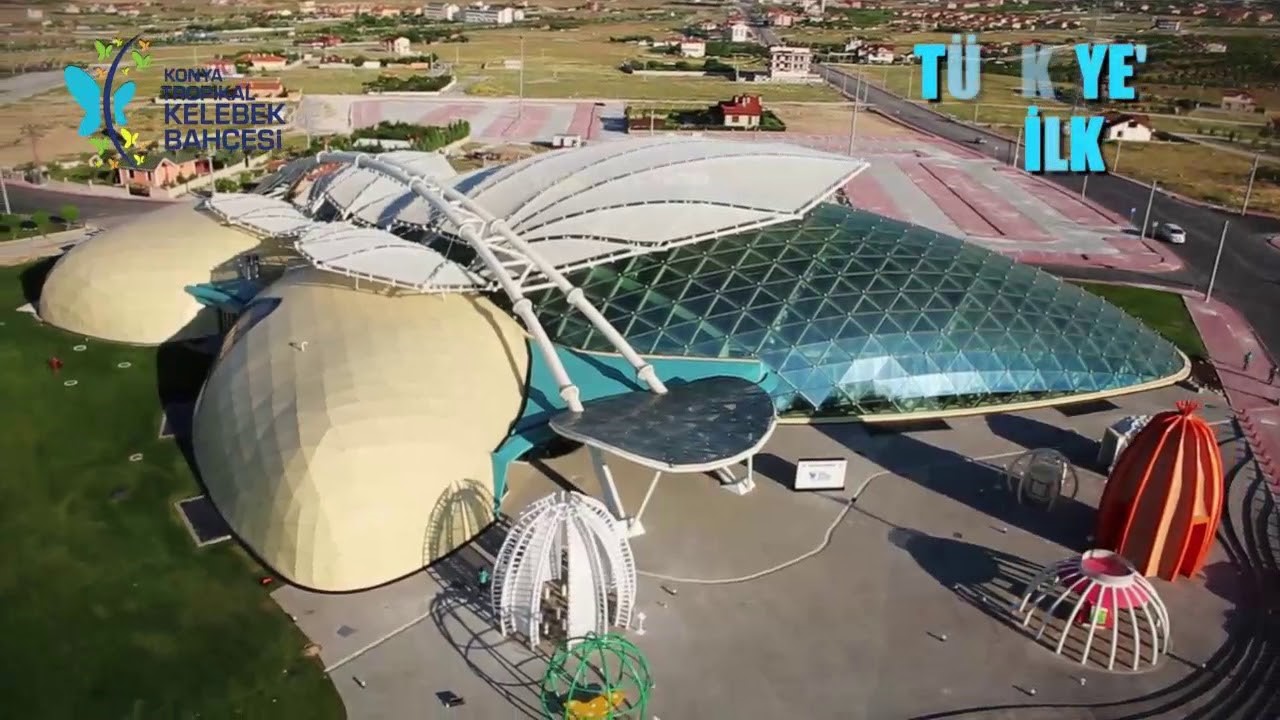
|
|
A fantastic new attraction for visitors to the city, at the Konya Butterfly Valley, visitors can see the lifecycle of butterflies at the Butterfly Manufacture Area, and wander among flying butterflies at the Open Flight Area. The areas where the tropical flora necessary for the survival of the butterflies are grown is another alternative for a beautiful sight.
In addition to being the first butterfly field in Turkey, the Konya Tropical Butterfly Garden and Butterfly Valley is also the biggest one in Europe.
|
Bedesten Bazaar (Roofed Turkish Bazaar)
|
|
.jpg)
|
|
The heart and the oldest bazaar of Konya, it is where you can find almost everything. Located near the Mevlana’s Tomb, Bedesten was constructed by the Mevlana Kadri Çelebi, the Mufti and Qadi in Konya during the period of Kanuni Sultan Süleyman (Suleyman The Magnificent) in 1538. The Arcade has a classic-type bedesten with nine units.
This bedesten is of the place for those who want to see different and authentic products, take photos, and buy souvenirs. In the Bedesten Bazaar where the ancient artisan culture still continues, especially in time for the Friday prayer, it is possible to see the tradesmen who left their products and went to the prayer.
This market surviving with the same boom for centuries has obtained its spectacular appearance by recently being restored by the Konya Metropolitan Municipality.
|
Konya-Beysehir Lake National Park
|
|
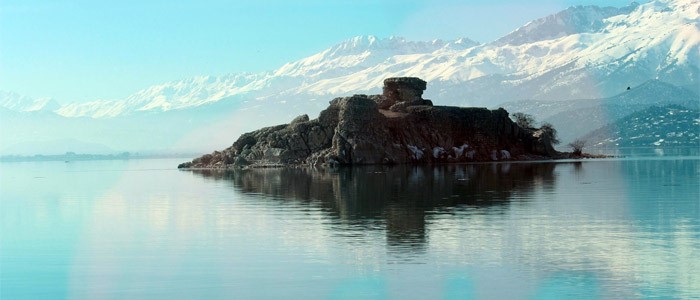
|
|
Lying in the middle of Isparta (105km) and Konya (94km), in the province of Beysehir, the 238th State Highway connects Konya and Beysehir, and the lake is just to the west of that. There is also transport by road from Isparta.
Beysehir lake is the third largest lake in Turkey; as a result of chemical reactions, it has formed many islands, which are the remains of cavernous geological structures. The water is alkaline; within it are carp, trout, bass, turtles, and eels. The islands provide a home for thousands of water birds that nest there, including swans, cormorants, ducks, and divers. Species of trees here include juniper, black pine, firs, cedar, and oak.
In addition to the natural beauty of the area, it also has an interesting history as it was governed by the Hittites, Friesian, Lydias, Persians, and Byzantines. Finally, the Anatolian Seljuks conquered the area in 1076; since then, it has been under the reign of the Turks. The remains of the Kubadabad Palace date back to the Seljuks and are found on Kizkalesi Island, 3km from the shore near Yenisarbademli village.
The Park is open between May and October; tents or caravans can stay in designated areas.
|
Beyşehir Eşrafoğlu Mosque
|
|
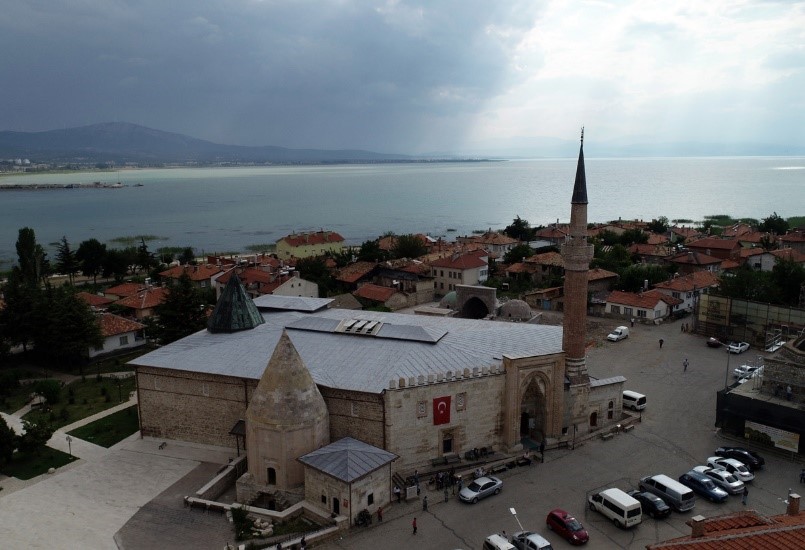
|
|
Located 100 meters north of Beysehir Lake, in the Esrefoglu Neighborhood, Esrefoglu Mosque was constructed in a rich cultural environment as a complex with a tomb, caravanserai, and a Turkish bath. The buildings around the mosque, like madrasah and badastan, belong to later periods. Esrefoglu Mosque was built in 1299, by Emir Suleyman Bey. |